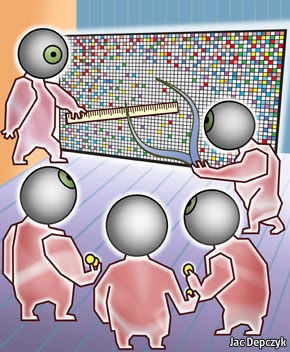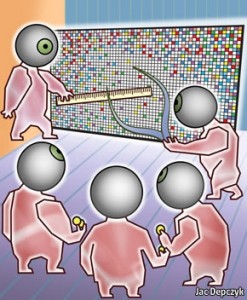
The devil in the details
Consumer electronics: Changes in technology mean that choosing a big-screen television has become more complicated than ever. Should you pay extra for 1080p resolution, LED backlighting or 3D? We crunch the numbers

IF YOU have not gone shopping for a new television set for quite a while, enough has changed to require some serious thought. So before splurging on a new high-definition television (HDTV) set, it is worth considering which features make sense and which do not.
Start with the viewing angles available in the room that will be used. THX, a technical standards-setter for the video and audio industries, requires the back row of seats in a home theatre to have at least a 26° viewing angle from one edge of the screen to the other. Seats nearest the screen should have a viewing angle of no more than 36°. These subtended angles correspond to a viewing distance of roughly 2.2 times the screen width at the back row of the seating, down to 1.5 times the screen width at the front. Within these limits, viewers should be able to enjoy the most immersive experience.
The question, then, is how to relate viewing distance to a person’s visual acuity. In other words, what is the maximum distance beyond which some picture detail is lost because of the eye’s limitations? Visual acuity indicates the angular size of the smallest detail a person’s visual system can resolve. Saying that someone has 20/20 vision (6/6 in metric terms) means that they can resolve a spatial pattern (a letter of the alphabet, say) in which each element subtends an angle of one minute of arc when viewed from a distance of 20 feet (six metres).
In other words, a person with 20/20 sight should, in normal lighting conditions, be able to identify two points that are 0.07 of an inch (1.77mm) apart from a distance of 20 feet. Twenty feet is taken because, as far as the eye is concerned, it is in effect infinity. Beyond this distance, some of the detail in the picture can no longer be resolved by the conical receptor cells in the retina of the eye. It will simply blend into the background instead of being seen as a distinct feature. Thus, it is a waste to make individual pixels—the tiniest elements in a display—smaller than 1.77mm across when viewed from 20 feet.
The problem with viewing images on a television screen—especially the “progressively scanned” 1080p HDTV sets in use today—is that most people sit too far back. At the typical distance of nine feet, a 1080p HDTV set (with a screen 1,920 pixels wide and 1,080 pixels high) needs to be at least 69 inches across (measured diagonally) if viewers are to see all the detail it offers. To see all the detail on a 32-inch set with 1080p resolution means sitting a little over four feet from the screen—great for video-gaming on your own, but hardly conducive to communal viewing.
In other words, viewers are not enjoying the full benefits of the higher pixel count of 1080p televisions if they sit any further back than 1.8 times the screen width. At a distance of 2.7 times the screen width, they might as well buy a cheaper 720p set, as the eye cannot resolve the finer detail of a 1080p screen at that distance.
The next choice that must be made is between plasma display, liquid-crystal display (LCD) or the latest light-emitting diode (LED) variety. Plasmas, with their rapid switching and deep blacks, have long been the favourite for sports fans and movie buffs. Apart from their lack of blur and judder when tracking fast-moving objects and their freedom from wishy-washy greys, they can be viewed from wider angles than LCDs without the picture changing colour. But plasmas have lately fallen out of favour because they are bulkier and more power-hungry.
To lick the LCD’s motion problems, manufacturers have developed special circuitry to predict and compensate for any rapid movement within a scene. This increases the screen’s frame rate from the 60 hertz (Hz) of conventional television to 120Hz and even 240Hz. A few manufacturers have begun offering sets with refresh rates of up to 480Hz, with 960Hz on the horizon. Unfortunately, the motion-compensating circuitry can make filmed content look like a cheap video—a glitch known in the trade as the “soap-opera effect”. The source of the problem is the way film shot at 24 frames a second has to adjust to the television’s much higher refresh rate of 60, 120 or even 240 frames a second.
One way of doing this is to analyse first one frame of film and then the next, and calculate an average of the two. This interpolated frame is inserted between the first and second frames, and the process repeated for each successive frame of the film. The interpolation process is good at removing blur and judder, but it can make the motion appear unnaturally smooth and disconcerting. Be warned: 240Hz sets are the worst offenders. For sports fans in particular, this gives plasma the edge.
Lastly, there are the LED sets. These are simply LCD televisions that use LEDs for backlighting instead of the usual fluorescent tubes. The LEDs can be either along the edges of the screen or spread as an array behind the whole of the display. Edge-lit displays have problems with uniformity of brightness, as well as a limited viewing angle. Apart from giving more uniform brightness, a full array of LED backlights allows the screen to be dimmed selectively in places where a scene needs to be dark. The effect is to make the LCD’s blacks appear almost as dense as a plasma’s. Only top-of-the-range LCD sets from Sharp and Sony currently have this feature. Expect to pay dearly for it.
2D or not 2D, that is the question
So, what to choose? All things being equal, plasma televisions are about two-thirds the price of their LCD equivalents, which are themselves up to a third cheaper than LED sets. Meanwhile, the premium that 3D sets once commanded has all but vanished. They are now worth buying, not so much for their ability to show 3D content, but because they display 2D even better than conventional plasma or LCD sets. 3D sets have special features to reduce “ghosting” in the image and maximise the 3D effect—and this ensures sharper 2D images, too. Happy viewing.